Part of the fun of growing plants in south Florida is that the climate allows us some unusual plants to work with. We put our growers to work, and we often discover beautiful, hardy varieties to add to our ongoing availability. We’d like you to be aware of some of our favorite Tropicals, and we promise that we’ll keep looking for plants that you can’t find just anywhere, to help keep your selection varied and fresh.

Pimenta Racemosa
Pimenta Racemosa, is a species of plant in the myrtle family (Myrtaceae) that is native to the Caribbean region. Common names include West Indian Bay Tree, Bay Rum Tree and Ciliment. It is used in cooking and essential oil is destilled to produce a fragant cologne Called bay Rum, although bay rum is essentially rum, the concentrated essential oil is toxic and renders the product undrinkable. The tree is 13 to 39 ft tall and the white flowers of about 10 mm wide become black oval fruits measuring 7-12 mm. The plants are now grown widely in other tropical areas. The ideal conditions for this tree are regular irrigation and bright sunshine.
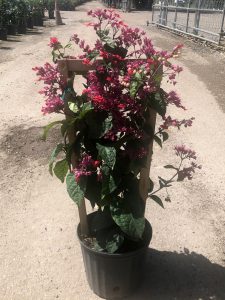
Bleeding Heart
Clerodendrum bleeding heart (Clerodendrum thomsoniae) is a sub-tropical vine that wraps its tendrils around a trellis or other support. Gardeners appreciate the plant for its shiny green foliage and dazzling crimson and white blooms. It is native to western Africa. Although some types of Clerodendrum are extremely invasive, Clerodendrum bleeding heart is a well-behaved, non-aggressive plant that reaches lengths of about 15 feet (4.5 m.) at maturity. You can train Clerodendrum bleeding heart vines to twine around a trellis or other support, or you can let the vines sprawl freely over the ground. Bleeding heart is suitable for growing in USDA zones 9 and above and is damaged in temperatures below 45 degrees F (7 C). However, it often regrows from the roots in spring. In cooler climates, it is commonly grown as a houseplant. Clerodendrum bleeding heart performs best in partial shade or dappled sunlight, but it may tolerate full sunlight with plenty of moisture. The plant prefers rich, fertile, well-drained soil. Water the plant frequently during dry weather; the plant requires consistently moist, but not soggy soil. Clerodendrum bleeding heart needs frequent fertilization to supply the nutrients required to produce blooms. Feed the plant a slow-release fertilizer every two months during the blooming season, or use a water-soluble fertilizer every month.
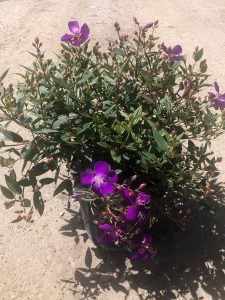
Tibouchina “Dwarf Jules”
If you like the color purple, Tibouchina is one plant you’ll certainly want to add to your garden. The most significant element of all Tibouchina plants, also known as Princess Flower or Glory Bush, is the strange shape of the stamens on it’s soft, purple flowers. Each stamen extends out and then develops a scimitar-like structure that is used as a “landing pad” for insects that collect the pollen on their feet. This dwarf form grows to only 24 to 30 inches tall. Prefers some shade during the hottest part of the day. A great little shrub for the front of the border. Also does well in containers with good potting mix and the right amount of water. Just keep soil slightly moist, not constantly soggy. Can be overwintered indoors in zones north of where it is hardy.
Sky Vine
Sky Vine Growing Sky vine (Thunbergia grandiflora) is a member of the tropical Acanthaceae family and is an evergreen in frost free climates, where it also produces fruits, but growth slows or stops in cool temperatures. It is hardy in Zones 8-11. The clusters of its trumpet flowers will enrich your garden with the vibrant feel from India, its origin. Dramatic lavender-blue flowers on a backdrop of dark green heart-shaped leaves will light up your garden all summer, or all year long in tropical climates. Sky vine growing is rewarding. The plant blooms profusely, and its stunning flowers make great cutting specimens for arrangements. This vine is ideal for covering a fence, pergola, large trellis, or an arbor. It sends out long wandering tendrils, which can even grab onto a nearby tree branch, becoming an interesting focal point in the garden. It’s this growth habit which gives the plant its name as well.
Horsetail (Equisetum hyemale)
Horsetail (Equisetum hyemale), is a non-flowering evergreen perennial. It has vertical green stems with horizontal bands, similar to bamboo, but the stems are skinny, like tall grass, and it reproduces through spores (not seed), like ferns. However, horsetail is not related to bamboo or grass or ferns. Its species dates back to Paleozoic times, some 350 million years ago. Horsetail grows in wet conditions and can even grow in standing water. For this reason, it is commonly used to decorate water gardens or swampy areas where few other plants can survive. It’s also commonly grown as an accent along borders or in large patio pots, similarly to ornamental grasses. Horsetail spreads via rhizomes and is such an aggressive spreader it would likely be considered invasive if it weren’t native to North America (as well as Europe and Asia); most plants classified as invasive are not native. So it is more accurate (in a North American context) to describe horsetail plants as aggressive spreaders. This is an important consideration when planting horsetail anywhere outside of a pot. To prevent it from taking over your garden or other planted ground, it’s advisable to use soil barriers or another form of containment.
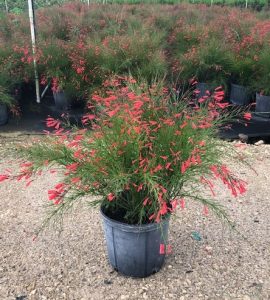
Russelia “Frirecracker Plant”
The firecracker plant is a great option for individuals seeking to add a pop of color to their yard. With showy red flowers, this plant will expand quickly across your Florida landscape. The plant grows up to three feet tall and will spread up to five feet wide.
The plant prefers regular moisture but can tolerate dry spells as well. You should cover the plant in colder weather or bring it inside. It attracts hummingbirds and butterflies.
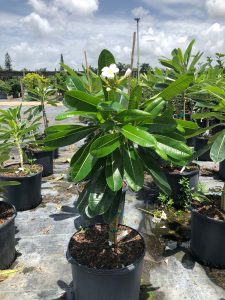
Plumeria Singapore (obtusa)
Is an evergreen shrub or small tree that grows up to 15 feet tall. It has scented creamy white flowers with a yellow center. This plant is best suited to a tropical climate where unlike most frangipanis, is reliably evergreen. It can be grow in frost-free subtropical climates but requires a sheltered position and constant water supply. Their fleshy branches contain a poisonous milk. In the tropics, the flowers (generally white) appear before the leaves and continue to flower for most of the year. In subtropical climates the flowers appear in spring, after the leaves and continue growing until the next winter. Singapore white is one of the loveliest plumerias and easily the most fragant plumeria known to exist.
Island Tropical Foliage is proud to be the largest grower of Aloes and Agaves in the southeast. Agaves are succulents that are popular for ornamental use, and feature thick, fleshy leaves. Many have sharp points and spiny margins. The most common Agaves are the Americana, Angustifolia, and Attenuata. Some of our favorites are the Agave Potatorum Blue Rose, and the Agave Parryi Truncata, but we have so many, it’s hard to choose a favorite! The Aloe plant is best known for its famous variety, Aloe Barbadensis, popularly known as Aloe Vera, which has been used for medicinal purposes for centuries, dating back to the ancient Greeks and Romans. There are many Aloe varieties which are decorative additions to any landscape, not only for unique look of the plants, but for the fact that they are drought tolerant. Check out a few of our favorites, which include the Dorotheae Sunset Aloe, and the Humilis Echinata Aloe Hedgehog.
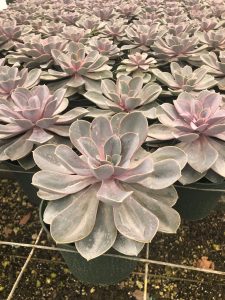
Echeveria ‘Perle von Nurnberg’
Beautiful rosettes of soft grey-brown leaves with deep pink highlights are dusted in powdery white. Bright coral flowers emerge in summer on foot-long reddish stems. Adds beauty to rock gardens and succulent collections. Tolerant of heat and drought. A frost-tender evergreen.
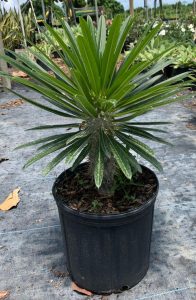
Madagascar Palm
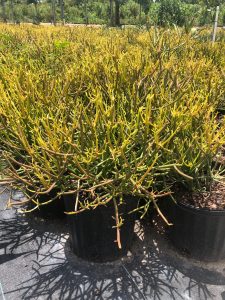
Pencil Cactus
The Pencil Cactus (Euphorbia tirucalli) is native to semi-arid tropical regions of Africa and India. In the wild, the Pencil Cactus can grow up to 30 feet tall. This stem succulent is not a true cactus and photosynthesizes in its stems, not through the small leaves that appear at the end of its new growth. As these plants evolved in dry climates with lots of sun, keep your Pencil Cactus in a bright location for maximum growth. This plant will not tolerate low light conditions. Direct sun or plenty of bright ambient light from a western, eastern, or southern facing window is ideal for this plant to thrive.
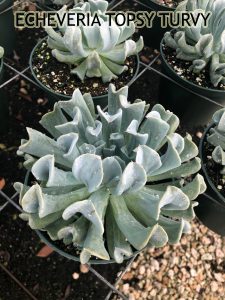
Echeveria Runyonii ‘Topsy Turvy’
An intriguing succulent with rosettes of thick, blue-gray, upward-curving leaves. Bright orange and yellow flowers rise above the foliage on tall arching stems in summer. Adds unique texture to rock gardens, borders, and container gardens. A frost-tender evergreen.
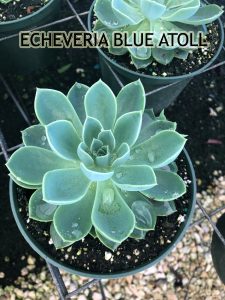
Echeveria ‘Blue Atoll’
Blue-green rosette with a soft look from its powdery coating of farina. This rosette has an open, lotus-like shape and lots of densely packed, cupped leaves. It grows wide (up to 10.0″) and offsets freely. In spring, it can send up a tall bloom stalk from which hang orange to yellow, bell-shaped flowers.
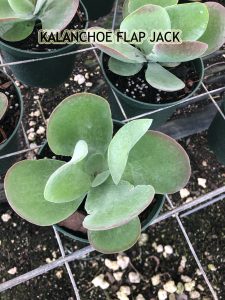
Kalanchoe Thyrsifora Flapjack
Commonly known as the Flapjack Plant, this plant is native to South Africa. Low care due to its drought tolerance and cold tolerance to 20-25 degrees, this flowering succulent produces chartreuse or bright yellow flowers. Kalanchoe are popular for use in rock gardens, and its blooms are attractive to bees, butterflies and birds. Kalanchoe Thyrsifora is unusual in that it grows in a rosette of flat, round leaves. Its average height is 12-18′.
From exotic fruits like Guava Pink and Lychee Brewster, to staples of many diets such as Musa Edible Banana and Black Mission Fig, what’s more practical than landscaping with edible trees and plants? You’d be surprised how many edibles provide beautiful flowers and shade, with the grand finale of delectable fruit. Peach Florida King, Dragon Fruit Zamorano, Carambola Kari Star Fruit, and so many more, why not add an entire fruit salad to your landscape plan?

Avocado-Choquette
The Choquette comes into season between the months of November and February. It is a medium sized spreading tree and is very productive. This avocado produces fruit heavily in alternate years. It has a mild flavor and 13 percent oil content. (Cold tolerance is 26 degrees F)

Avocado Lula
The Lula avocado comes into season between the months of November and February. It is a cross between Guatemalan and Mexican type avocados. A taller variety, dense and broad, it is rapid growing and productive and bares when young. The fruit has a 12-16 percent oil content. The Lula was recognized for its excellent eating qualities, cold hardiness and productivity.

Avocado Simmonds
The Simmonds comes into season between the months of July and August. The actual tree can grow to a height of about 30 feet and reach a width of 20 feet. It produces a fruit weighing about 1 to 1.5 lbs. This avocado is considered a good producer with excellent eating quality. (Cold Tolerance 28 degrees F)

Avocado Bernecker
The Bernecker avocado tree can reach a height of 30 feet and a width of 20 feet producing a large pair shaped fruit that varies in size from 1.5 to 2.5 lbs. It is considered a good producer and the fruit has an excellent flavor.

Carambola Arkin
The Arkin variety is the most successful cultivar commerce due to it being firm and compact, making it easy to pick, pack and ship. This star fruit tree produces a medium sized fruit that is very sweet juicy and firm with few seeds.

Carambola Fwang Tung
The Fwang Tung carambola tree will grow to reach a height of about 35 feet. This star fruit is crunchy and large, measuring 6 inches tall and 4 inches wide. It is semi sweet and pleasantly mild tasting.

Eriobotrya Japonica, Loquat
Also known as the Japanese or Chinese Plum, this large evergreen scrub or small tree can grow to 30 feet tall, but typically tops out at 10 to 13 feet. Grown primarily for its very tart 1-2 inch yellow or orange fruit, it is sometimes also used as an ornamental shrub. Fragrant 1 inch white flowers may be found in autumn to early winter, followed by clusters of fruit. The Loquat trunk is short, and its leaves are dark green and glossy on the topside. (Hardiness Zones 8-10)

Guava Pink
The Guava tree can grow to reach a height of 30 feet plus. It produces a round oval shaped fruit 2 to 4 inches long, light yellow skin blushed with pink. The guava thrives in both humid and dry climates and is not cold tolerant at all. Guava trees grow rapidly, and the fruit matures 90 to 150 days after flowering.

Lychee Brewster
The second most common commercial lychee variety or cultivar in South Florida is the Brewster. The fruit is medium to large, sweet and juicy. The fruit usually ripens during the month of June and as it does, it turns from a pinkish red to a bright purplish red. The Brewster lychee grows best in areas where it will get a lot of irrigation or natural rainfall.

Mango Glenn
The Glenn tree is relatively small and produces a compact rounded canopy. The fruit is oval to oblong in shape with a rounded base and pointed apex. The fruit turns bright yellow when ripe. The Glenn is a Haden seedling.

Myrciaria Cauliflora, Jaboticaba
This small, bushy tree is native to Brazil, where it is considered one of the most popular native fruit bearers. It is unique in that flowers, and resulting fruit, grow directly from the trunk. Also called the Brazilian Grape Tree, in full sun this slow growing tree (when grafted), will produce fruit in about 5 years. Seedling trees may take 10 years or more to bear fruit, which are eaten like grapes. Although most trees mature to 10-15 feet tall, in the native environment they are found up to 45 feet tall. Its canopy is typically as wide as its height. Fairly cold tolerant, Jaboticaba are highly ornamental due to its dense multiple stems. (Hardiness Zone 8)

Mango Tommy Atkins
The Tommy Atkins fruit is medium to large in size weighing 16 to 25 ounces. The flavor is fair to good maturing between June and July. Tommy Atkins met the criteria for commercial production which is why it has become the most planted mango throughout Florida.

Mango Keitt
The Keitt tree is a vigorous grower but does not tend to get much bigger than 20 feet in height. The fruit of the Keitt is large reaching up to several pounds in weight. The fruit has good disease resistance and typically ripens from August through September. The fruit is fiberless tangy and sweet and considered to be great eating quality.

Avocado-Brogdon
The average height of the Brogdon Avocado is about 25 feet and width is about 20 feet. The Brogdon goes into season between the months of July and September. The actual tree is moderately vigorous also moderately productive. The Brogdon is a very hardy variety and has a very similar flavor to the Haas avocado. (Cold Tolerance 22 degrees F.)

Avocado Day
The Day avocado comes into season between the months of July and September. It is a more slender tree and very productive. The fruit has a buttery consistency and a delicious nutty flavor. It is a medium sized easy to peel avocado. (Cold tolerance 22-25 degrees F)

Avocado Monroe
The Monroe avocado comes into season between the months of November and January. It reaches an average height of about 25 feet and a width of about 20 feet. It is a heavy bearer with a round oval and pebbled fruit that has a nutty flavor. Its oil content is about 10-14 percent. (Cold tolerance is 26 degrees F)

Avocado Winter Mexican
The Winter Mexican avocado is an attractive spreading tree, very vigorous and heavy. It is considered a regular barer and resistant to scab. It has a 30 percent oil content. The fruit is oval shaped with a rough texture. (Cold Tolerance 22-24 degrees F)

Barbados Cherry
The Barbados Cherry is a large bushy shrub that can reach up 20 feet in height and an equal width. The plant bares white silky irritating hairs when very young, and hairless dark green and glossy when mature. It produces round cherry like fruit, which is lobed .5 to 1 inch wide and bright red . Young plants are killed by any drop below 30 degrees F. They can tolerate drought, though they may not fruit until the coming of rain. It mainly fruits in spring and can also ripen in December.

Carambola Kari
The Kari carambola tree, aslo known as star fruit, can reach a height of 10-16 feet. Its fruits are star shaped and are yellow-orange when ripe. The carambola will fruit from mid-summer to mid-winter. The Kari will exhibit more cold tolerance than other carambola varieties. This variety is said to have an excellent flavor.

Carambola Sri Kembanqan
The Sri Kembanqan Carambola (star fruit) can reach a height of between 20-30 feet. This carambola prefers partial to full sun and loves moisture. The Sri Kembanqan variety produces fruit that is bright yellow-orange in color and sweet. The fruit averages 4 to 6 inches in length and 3 to 4 inches in width. It is of excellent eating quality.

Dragon Fruit- Zamorano
The Dragon Fruit- Zamorano is self-pollinating and produces a roundish red fruit with dark red pulp. It gets its name from the Agriculture University in Honduras. The fruit average half to one pound in size. It blooms huge nocturnal blooms over 14” across during the summer. The Dragon Fruit plant prefers shade at the feet but full sun at the tops to bloom well. Fruits are developed after blooming and ripen by midsummer to fall.

Longan
The Longan tree can grow up to 30 feet plus in height. It is a little more cold hardy than the lychee, and does not usually do well in temperatures below 30 degrees. Season of ripening in South Florida is between the months August and September.

Mango Carrie
The Carrie mango produces a small fruit averaging a pound or less and ripens from June to July. The flesh is not fibrous and is very rich in flavor. The fruit does not develop red blush like other mangos. At maturity it may be green to yellow.

Musa Banana
These edible bananas are available in several varieties, including the Ice Cream banana, Blue Java, which produces sweet, creamy fruit. This is one of the most cold hardy bananas, appropriate to zone 8. The Namwa banana is in the ladyfinger grouping, and produces a sweet, tasty fruit. Both varieties described grow to 10′ at maturity. Fruit grows in bunches, and these long, hanging clusters may contain 3-20 tiers (also known as hands) which may produce up to 20 bananas each.

Mango Haden
The Haden mango tree is a vigorous grower capable of reaching heights between 20 and 30 feet. It produces fruit averaging 1 to 2 pounds in weight which reach maturity from June to July. The flesh is slightly fibrous but has a full sweet flavor. The Haden mango has become of the most widely cultivated mangos in the world.

Mango Julie
The Julie mango was recognized for its outstanding flavor and its dwarf growth habit. It is very susceptible to fungus due to the high levels of humidity in Florida. Its fruit is small averaging less than a pound at maturity. It is deep orange colored fruit; juicy and rich in flavor, not fibrous. The tree usually stays within 8 feet in height.

Peach Florida King
The Florida King peach ripens in early May. It produces a fruit measuring 2-2.5 inches in diameter. It has red blushed skin and golden yellow flesh. Hardiness zone 8B-9.
Beachfront properties and tropical climates are logical locations for Salt Tolerant and Native plants. Many of these are also drought tolerant, so don’t forget them when you are planning rock garden landscapes. Jamaica Caper, Capparis Cynophallophora, Canella Winterana, Wild Cinnamon Tree, and several varieties of the hardy Clusia, are just a few examples of the varieties that we grow. Many of these unique Tropicals are appropriate for many climates and are sure to add an unusual touch to any landscape design.

Jamaica Caper, Capparis cynophallophora
Native to Florida, Jamaica Caper is a slow growing, upright shrub, often used as a spreading plant. It can grow to 20’ tall, but is typically not seen over 15’ tall, with an 8-12’ spread. Glossy, oval leaves are folded together when they first emerge, and due to the brown scales on the undersides of these leaves, new growth has a bronzed appearance. This plant’s leaves are light green; white flowers are showy, with a purple stamen. Look for flowers in spring, followed by 3-8” fruit which grows in a cylindrical pod. This is a dense, salt and drought tolerant plant, which may be planted in full sun or partial shade. Hardiness zones 10-11.

Clusia Guttifera Small leaf
Often used as a hedge due to its density and branches that grow close to the ground, and its stiff, paddle shaped, leathery leaves, Clusia Guttifera is a low maintenance, moderately growing plant. You may allow it to grow to 25’ tall, but it is typically trained as a hedge, 8-10’ tall, spreading as wide as it is tall. It is not only salt and drought tolerant, but it’s pest resistant too. Plant in deep shade or in full sun; small, pink flowers are rare and typically only bloom in full summer heat. Hardiness zones 10-12.

Clusia Rosea, Nana Dwarf Pitch Apple
A low growing, spreading shrub, Clusia Rosea is known for its unusual foliage; dark green, shiny, thick, paddle shaped leaves which grow 2-5” long. A lovely border or ornamental plant, it thrives in hot, tropical weather. Clusia Rosea is typically planted as an accent plant or hedge due to its density and highly textured foliage, rather than for its flowers. Fragrant flowers peak in spring, and are white with an orange center. Nana Dwarf Pitch Apple typically only grows to about 2’ tall, but may spread to 2-3’ wide. Easy care, it is drought and salt tolerant, and may be planted in light shade to full sun. Hardiness zones 10-12.

Guaiacum Sanctum, Lignum Vitae
The Lignum Vitae is a beautiful native of Florida and the Caribbean; and is the national tree of the Bahamas. Its dense, dark green, thick and waxy foliage make it desirable as small, ornamental tree. Its wood is prized for its denseness. A slow grower, Lignum Vitae has an average height of 10-15’ with an equally sized canopy spread. 5-petaled flowers are most often seen in spring, and are typically blue to purple. They are occasionally seen in white, and are lightly fragranced. Heart shaped, flat fruit capsules contain one or two seeds which push from the fruit when ripe. Plant in partial to full sun. Lignum Vitae is moderately drought tolerant and salt tolerant as well. Hardiness zones 10b-11.

Suriana Maritima, Bay Cedar
This slow to moderately growing evergreen shrub can reach up to 20’ tall, but is typically smaller. Found mainly around sand dunes and rocky shores, Bay Cedar features a sturdy, branched trunk with dark brown, rough, flaky bark. Its wood is hard and heavy. Small, fleshy, gray green leaves have a cedar like fragrance when crushed. Yellow cup shaped flowers are set among the leaves in singles or clusters, and can be seen throughout the year. Plant in full sun, Bay Cedar is drought and salt tolerant. Hardiness zones 10b-11.

Canella Winterana, Wild Cinnamon Tree
Wild Cinnamon Tree can reach 20-30’ tall, spreading 6-8’ wide. Shiny, thick , leaves are medium to olive green in color, and are on thin branches that grow to a maximum of 4’ long. This evergreen shrub or small tree may be trained into a canopy, but it is most often used as a hedge. It’s a dense, slow grower, which features small red-orange flowers that will bloom in summer and fall. Blooms are followed by bright red berries which cluster at the end of the branches. A Florida native, plant in full sun or partial shade for best results. Wild Cinnamon is drought and salt tolerant. Hardiness zones 10b-11.

Clusia Rosea, Pitch Apple
Also known as the Autograph tree, as the broad, thick, dark green leathery leaves are thick enough to write on with a fingernail, Pitch Apple is a wide spreading, densely foliated evergreen tree. Its spread at maturity is 15-25’. A moderate grower, this ornamental tree features a short trunk, and grows to 25-30’ tall. In summer, showy 2-3” pink and white flowers bloom nightly; often remaining open on overcast mornings. Fleshy, light green poisonous fruit grows to 3” in diameter, turning black when they are ripe. Clusia Rosea may be planted in full sun or partial shade, and is salt and drought tolerant. Hardiness zones 10B-11.

Clusia Lanceolata
This hardy, slow grower is one of the least common Clusia varieties. It is also called the Balsam Apple, and makes a beautiful ornamental shrub or tree, growing to 8-10’’. The Clusia Lanceolata is salt tolerant, and somewhat drought tolerant, making it a low care plant to maintain. It’s leathery, thick leaves grow to about 3’’ long. Blossoms may be red, scarlet, or white, and measure 1-2’’ across. This plant likes full sun to light shade. Native to Brazil, the Clusia Lanceolata was chosen by world renowned Fairchild Tropical Gardens in Miami as one of its top 3 PLANTS OF THE YEAR in 2007.

Exothea paniculata, Inkwood
Also known as Butterbough, Inkwood makes an excellent accent tree. The beautiful canopy makes a dense crown, and tops a medium sized tree with a tall trunk. Its height is typically 25-35’ and it is taller than it is broad. Its trunk is 6-15” in diameter, featuring reddish brown bark. This medium to slow-growing tree features long (2-5”), glossy leaves and tiny fragrant blooms in spring and early summer. Produces red berries that ripen to deep purple. Moderately salt and drought tolerant, Inkwood does best when planted in full sun to partial shade. Hardiness zones 10-12.

Pseudophoenix Sargentii, Buccaneer Palm
A very slow grower, the Buccaneer Palm thrives in hot, tropical weather. Its single, smooth, gray trunk is ringed with the scars of palm fronds that have shed. It grows to be about 15’ tall. One of its features is its swollen trunk, and the variation in its frond colors, which may be green, light green, blue green, or silver. This makes each Buccaneer truly unique. Fronds may grow up to 15’ long, and generally self shed. Native to Florida and the Caribbean, fronds stems spread out in a flat, fan-shaped pattern. Salt and drought tolerant, this palm is pest-free as well. Plant in full sun or partial shade. Hardiness zones 10a-11.

Wedelia Trilobata, Wedelia
Also known as Singapore Daisy, Creeping Oxeye or Trailing Daisy, Wedelia is in the sunflower family. This dense ground cover can be invasive, and will form a mat that blooms profusely. Flowers are bright yellow, about 1”, and feature 8-13 petals per head. Wedelia will grow to a height of 6-12”, and spreads very quickly. Fleshy, hairy leaves are dark green above, and light green below. Rounded stems root at the node. Wedelia likes full sun, is drought tolerant when established, and is salt tolerant as well. Hardiness zones 8b-11.
Did you know that we are growing mangaves? Well yes we are! What is Mangave? Mangave is a relatively new phenomenon, as a cross between the genus Manfreda and Agave. These rare hybrids combine the best of both worlds: the better growth rate and the interesting patterns of Manfreda and the habit and refinement of Agave. Growers will appreciate the fast growth rate of Mangave, these hybrids finish more quickly than Agave, thanks to their Manfreda parentage. Our colection includes the following varieties:
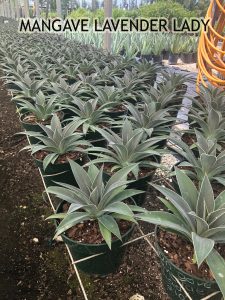 Mangave “Lavender Lady”
Mangave “Lavender Lady”
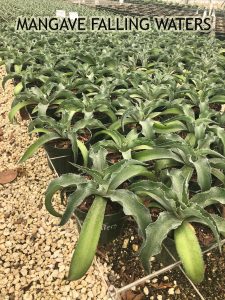 Mangave “Falling Waters”
Mangave “Falling Waters”
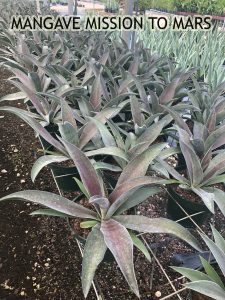 Mangave “Mission to Mars”
Mangave “Mission to Mars”
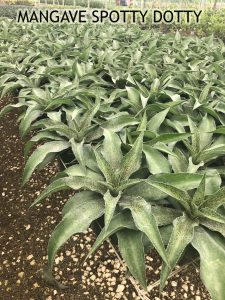 Mangave “Spotty Dotty”
Mangave “Spotty Dotty”
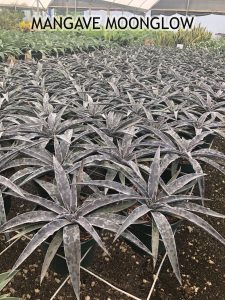 Mangave “Moonglow”
Mangave “Moonglow”
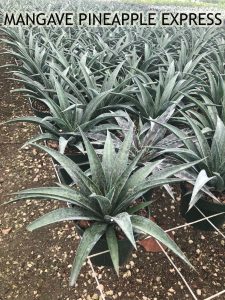 Mangave “Pineapple Express”
Mangave “Pineapple Express”
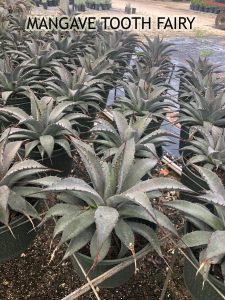 Mangave “Tooth Fairy”
Mangave “Tooth Fairy”
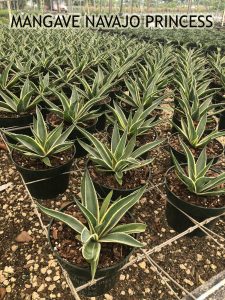 Mangave “Navajo Princess”
Mangave “Navajo Princess”
We are in the process of adding a line of 6” foliage to our current inventory. Some varieties are already in production and more will be added throughout the year. These are indoor plants grown primarily for their great looking and interesting leaves, rather than flowers.
What is your favorite?
HOW TO CARE FOR YOUR FOLIAGE PLANTS
WATERING
Foliage plants are adapted to regions where soil is moist, but not continually saturated with water. Therefore, never allow soils to become completely dry. Watering frequency will depend on weather, type and size of plant and stage of plant growth.
SOILS AND REPOTTING
Foliage plants can be grown in a great variety of soil mixes, but are easier to care for if planted in soils containing high levels of peat moss. Such soils retain water and fertilizer and provide good aeration if peat moss is mixed with coarse sandy soils or perlite.
FERTILIZATION
When foliage plants are used for interior design purposes, little fertilizat1on is required, in most cases four applications a year will be sufficient unless considerable new growth is desired. Over-fertilization we’ll cause a slowdown of growth, stunted plants, burned or dried leaf margins and wilted plants.
CLEANING FOLIAGE
When foliage plants are grown indoors, dust and other undesirable residues will accumulate on foliage and become unsightly, but most foreign matter can be removed by wiping foliage with a, soft moist cloth. A small amount of hand soap may be added to the water when stubborn spots are encountered. Don’t fold, crease or rub leaves too hard, as they may be damaged.
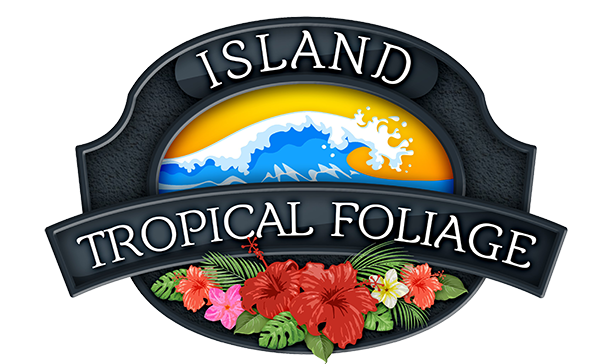
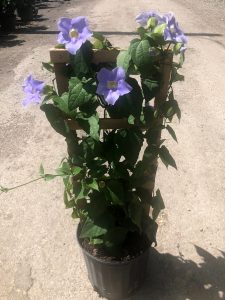
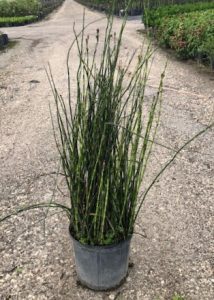
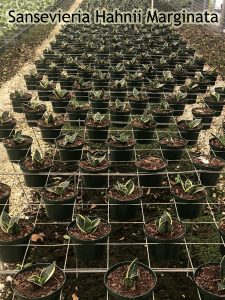
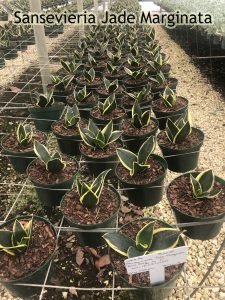 Sansevieria Jade Marginata
Sansevieria Jade Marginata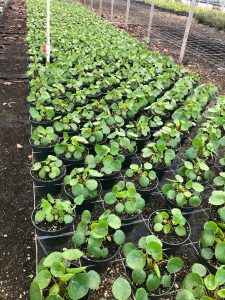 Pilea Peperminoide “Chinese Money Plant”
Pilea Peperminoide “Chinese Money Plant”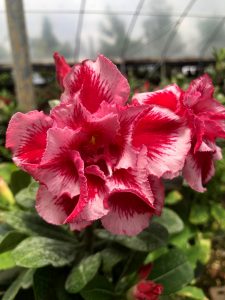 Adenium Obesum Double Bloom “Grafted Desert Rose”
Adenium Obesum Double Bloom “Grafted Desert Rose”